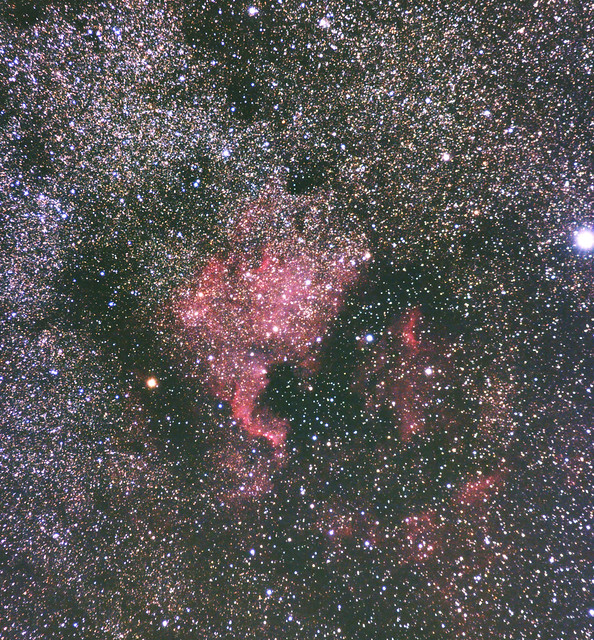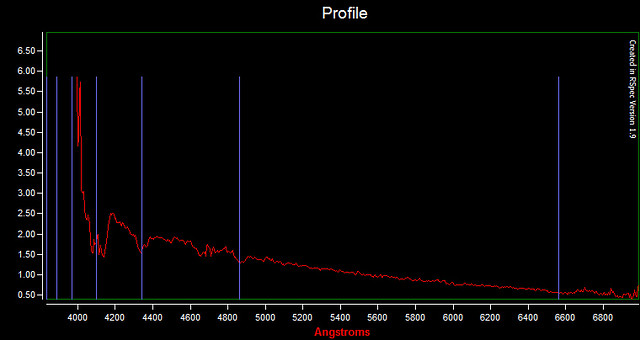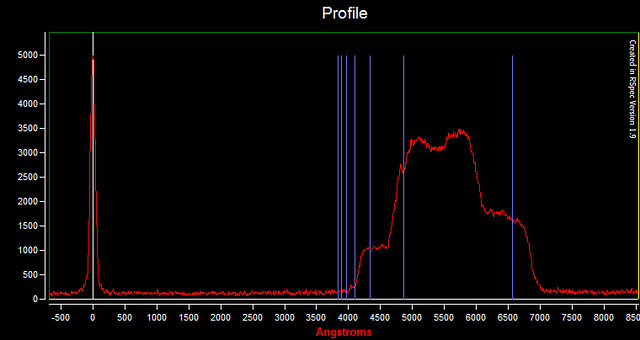|
Observing Log for Mike Durkin
9/26/17 about 9:00PM-10:00PM
Locust Valley, NY
Transparency: 7/10, Seeing: ?/5
Temperature: 65-75
I wanted to test out the 500mm cat lens a bit. I started with a couple of images of the crescent moon.
My initial test makes me think that this may not work for photometry. The slightly out of focus stars
weren't nice circles, but looked like stars after a "mirror slap". I think I am a bit happy with the
focus I was able to achieve, but I will need to look at the images to really be sure.
I also think the images were darker and maybe significantly noisier compared with the 75-300 zoom
lens. It may be interesting to see how this works as a piggyback on the 8 inch. Also star hopping
is difficult, I may need to use some of the smaller lenses to get into the general area first.

Cropped image of the moon using the 500mm lens
|

|

|

|
|
Various images of stars to test the 500mm lens. The middle image is the sharpest of the 3, but even so te stars are not
nice points. There's a "bump" on the top of all the stars.
|

|

|
|
A couple of images around the ring nebula using to 500mm lens. The nebula is easily visible just to the left, although I'm not
happy with the star shapes in either frame. Although this may be due more to tracking rather than defects in the lens.
|
9/23/17 about 9:00PM-11:00PM
Locust Valley, NY
Transparency: 9/10, Seeing: 2-3/5
Temperature: 65-75
Equipment: Celestron Ultima 8 with PEC
Saturn Nebula, relatively bright and a definite oval shape. I tried to use additional magnification (7.4mm ad 2x barlow),
but was never able to make out any details.
M72 globular cluster - only suspected that I was able to make out the core.
M2 globular cluster - bright, @7.4mm starting to resolve stars.
M15 globular cluster - Also bright, @7.4mm and 7.4 + 2x barlow, was starting to resolve. It also had a bit of a
"sparkle effect", as I moved by eye around, some stars would "pop" in and out. The stars may have been part of the
globular or just other field stars.
Visually measured variable stars R Del and S Del.
9/10/2017 about 9:00PM-12:30AM
Locust Valley, NY
Transparency: 9/10, Seeing 2-3/5
Temperature: about 55-65 degrees
Equipment: Hutech modified Canon T3i and Star Adventurer mount
Today I wanted to see if using the counterweight with the Star Adventurer would work out
as expected. It did seem to, however I think I lose some flexibility with orienting the
camera lens and framing. The batteries on the polar scope insert also seem to be near
dead, so I think I need to get new ones.
First off, I tried to image NGC 7000 and the nebulae around γ Cyg in one frame.
I thought I would get away with 100mm, but even at 75mm, each nebulae was near the edge
of the frame. After the lens dewed up, I cut my losses on the two nebulae shot and instead
decided to bump up the zoom lens and focus on NGC 7000.
The shot for NGC 7000, seemed to go more or less OK, but dew was a problem all night. I
didn't get as many shots as I wasnted and I had to discard a bunch. The whole night took
longer than I wanted to because of that.

|
Camera: Hutech modified Canon T3i
Location: Long Island, NY
Lens: 70-300mm at 70mm, f/6.3
Exposure: 21x60 seconds (21 minutes)
Processing: calibrated with flat and dark frames. Processed using MaximDL, Photoshop, GradientXTerminator plungin and Astronomy Tools plugin
|

|
Camera: Hutech modified Canon T3i
Location: Long Island, NY
Lens: 70-300mm at 136mm, f/6.3
Exposure: 39x60 seconds (39 minutes)
Processing: calibrated with flat and dark frames. Processed using MaximDL, Photoshop, GradientXTerminator plungin and Astronomy Tools plugin
|
9/9/2017 about 9:30PM-11:30PM
Locust Valley, NY
Transparency: 6/10, Seeing 3/5
Temperature: about 55-65 degrees
Equipment: Stellarvue 70mm refractor and 60mm Mak
Even though the day was mostly clear, by the time I was observing there was a significant
amount of clouds. Although there were also some decent patches of clear and most of the
clouds stayed to the north.
I started out comparing the 70mm refractor with the 60mm Mak. I would say that the Mak
is significantly darker, although the stars seemed to be better focused with the same 30mm
eyepiece. The Mak is probably best used for planets or very bright stellar objects.
I ended up using the 70mm refractor to mearure variable stars R Aql, RR Aql, V Aql and
CT Del.
After that I looked to see if I could observer globular cluster NGC 6934, which was
close to CT Del. I used the 7.4mm eyepiece (57x) and I was able to make out a small
non-stellar fuzzy patch. I suspect that I was only observing the core of the globular
cluster based on the description I had.
9/4/2017 about 8:00PM-11:00PM
Locust Valley, NY
Transparency: 9/10, Seeing ??/5
Temperature: about 60-70 degrees
Equipment: Hutech modified Canon T3i and Star Analyser 100 grating
Did some DSLR photometry of P Cyg, CH Cyg and a new target that is also part of a program,
VV Cep.
Then I decided to try the Star Analyser filter grating again. I started with the 50mm
lens and Vega. I then tried using the 75-300mm zoom lens, set at 75mm. That seemed to
produce a better spectrum, but with the aperture set to something normal, the red and
blue parts of the spectrum were clearly out of focus. It did seem to improve significantly
when I brought it down to around f/10, but that also significantly increased the
required exposure time. Bringing the spectra into Rspec, the Hydrogen beta line was well
defined, but the Hydrogen alpha and gamma lines were not as easy to disinguish.
I also tried to get an spectra of P Cyg, but the intensity seemed to be too low to
be useful.
Next steps for spectra I think....If I am doing a drift image, then I need to be sure
that the lines are closer to perpendicular to the drift direction. Or maybe I do tracking
and have to be sure that the polar alignment is much more accurate.

|
A spectrum of Vega, using a 50mm lens
|

|
Unprocessed spectrum Vega
|

|
Processed spectrum of Vega along with a reference spetrum of an A0V star as given by Rspec. Hydrgen beta and gamma lines
are clearly visible. The hydrogen alpha line seems visible in the original image, but after processing it seems to be
getting lost.
|

|
A spectrum of Vega, this one with a zoom lens set at 70mm
|

|
Unprocessed spectrum Vega from zoom lens set to 70mm
|

|
|
Processed spectrum of Vega from zoom lens at 70mm along with a reference spetrum of an A0V star as given by Rspec.
This spectrum is more "noisy" than the 50mm lens. Although the Hydrogen Beta line is clearer. Hydrogen Alpha is
drowned out a bit in after the instrument response is accounted for, although there's a hint of it in the unprocessed
spectrum.
|

|
A spectrum of P Cyg, this one with a zoom lens set at 70mm, exposure 2 miutes at f/10
|

|
Unprocessed spectrum of P Cyg from zoom lens set to 70mm with marks for where Hydrogen Balmer lines would be. The Hydrogen alpha
line is visible in both the spectrum image and the profile, although other lines are questionable at best. This was a very noisy
spectrum, so I didn't bother working on it too much. I hope one day to go back to this star to get a better spectrum.
|
9/1-2/2017 about 11:30PM-1:00AM
Locust Valley, NY
Transparency: 5/10, Seeing ??/5
Temperature: about 60-70 degrees
Equipment: 60mm Mak, Star Analyser 100 grating and Hutech modified Canon T3i
First light for a couple of items I purchased at the convention in Casper, Wyoming.
I set up the 60mm Mak on the AstroTrac and camera tripod. Then I attached the DSLR
camera body to it. Even though the 60mm telescope is light and relatively small, trying
to maneuver it on the ball head was still slightly difficult.
I initially used the moon to test focus, but I didn't use any eyepieces, so I didn't
really put the Mak to the test, but they view on the camera LCD display seemed nice
enough.
But the main reason was for me to test out the Star Analyser 100 grating. I used a
T ring on the camera body and a 1.25 inch nosepiece threaded into the T ring. I was
then able to screw in the grating into the nosepiece.
Pointing the scope and trying to eyeball the scope location proved to be very difficult
because even bright stars were not easy to find. I ended up having to pull out the
finderscope from the 5 inch Mak and use that, which did help a lot.
I tried to take some initial spectra of Vega, Altair, R Lyr, η Lyr and I think
θ Lyr.
Clouds were present the entire time, although they were usually thin enough or sparse
enough that I could get the images of the spectra without too much difficulty or to
justwait a couple of minutes.
I have taken a quick look at the spectrum using RSpec, and some lines for each star
were visible. However the Hydrogen Alpha line was not always visible in Vega's
spectrum. Also comparing the intensity profile of my results with similar results
I can find online, the general intentity profile has a different shape. This is
almost certainly due to the modified Hutech filter replacement that was added in.

|
Spectrum of my first star, most likely Vega, with Star Analyzer grating.
|

|
|
Unprocessed spectrum of first star with Hydrogen Balmer lines marked
|

|
Processed spectrum based on an A0V type star, with Hydrogen Balmer lines marked.
The line for hydrogen alpha is barely noticeable, perhaps because I could only focus
on the hydrogen beta and gamma lines. There is also an artifact around 4600 angstroms.
This is possibly because of the Bayer matrix where the green and blue channels meet up.
I was not able to get a good enough instrument response curve to eliminate it.
|

|
Another sprectrum, probably Altair or maybe Vega again.
|

|
|
Unprocessed spectrum of the second star of the session with Hydrogen Balmer lines marked
|

|
Perhaps my second star of the evening, either Altair or maybe Vega again. I wasn't keeping track too well.
This time I used the profile of an A7V star, which is the spectral type of Altair. The hydrogen gamma
line seem to be more distinct here compared to my previous star and that dip around 4600 is also there
again.
Could the dip around 6900 angstroms be some noise or O2?
|

|
A spectrum of an M type star, most likely R Lyr. There seems to be a hot pixel in between the star and the spectrum.
|

|
Unprocessed spectrum of an M type star, probably R Lyr. The blue lines are for an M type star.
|

|
The processed spectrum of an M type star, probably R Lyr. I used the instrument response profile
from the A7V star on this since I didn't like the instrument response curve I was getting using
an M5III star, I have to find out if the instrument response curve is constant for different
spectral classes. Most of the absorption lines match up with the projected wavelengths, but I do
wonder if the calibration is not linear.
|

|
A spectrum of Eta Lyr
|

|
Unprocessed spectrum Eta Lyr. The blue lines are for Hydrogen Balmer lines
|

|
|
Processed spectrum of Eta Lyr. Hydrogen Alpha and Beta lines are not visible. Not too surprising for the
H-alpha line, but the beta line should have been there. Hydrogen gamma line was there, although it
didn't line up quite as expected.
|

|
A spectrum of Theta Lyr
|

|
Unprocessed spectrum Theta Lyr.
|

|
|
Processed spectrum of Thera Lyr along with a reference spetrum of a K01II star as given by Rspec.
The overall shape matches pretty well except maybe a bit around 4000-4200 Angstoms. Some of the
sharper lines in the reference from 5800 and above do not show up clearly if at all in my spectrum.
I also have a dip around 6800-7000 Angstoms.
|
Other Log Entries
<-- 2016 Jan
Feb
Mar
Apr
May
Jun
Jul
Aug
Sep
Oct
Nov
Dec
2018 -->
|





























